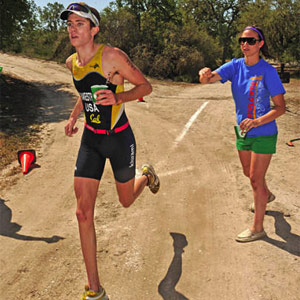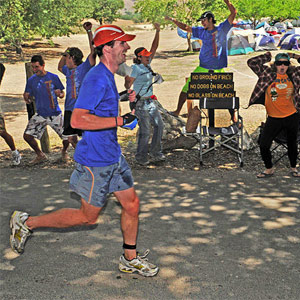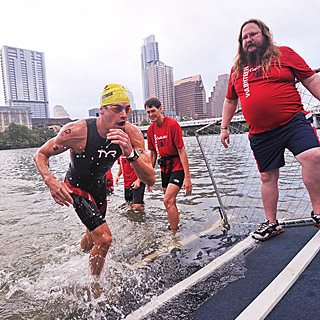It’s the law

Unless otherwise waylaid, I arrive at races very early, and as part of my pre-race routine I make a pest of myself—if need be—until I'm satisfied I know with precision the swim, bike and run courses. Am I allowed to run up the beach or not if the swim course takes off at an angle from shore? Which way in and out of transition, both for bike and run? Can we ride from and to the racks, or are their mount/dismount lines (Article VII—Transition Area Conduct—does not specify)? If the latter, can we run to the mount line or must we walk? And so forth.
Still, sometimes events overtake one's best effort to equip oneself per the dictum to "Know the Course."
I spoke with both Jimmy Riccitello, who heads up WTC's officials program, and Charlie Crawford, the longtime head of officiating at USA Triathlon. I asked them both what they might like to say to our readers, going forward, when faced with issues like those posed at this past weekend's CapTex Triathlon.
They were unanimous in saying this: When on land, it's clear, athletes must know the course. This responsibility belongs to the athlete alone. "Course Knowledge" is embedded and enshrined in the rules—triply so.
"Race rules, 3.4.a—that covers everything, that takes precedence over all," said Crawford, when asked whose responsibility it is to know the course. He refers to the phrase under 3.4 (Race Conduct), that says, "… It is the participant’s responsibility to know the course."
This is backed up by similar text in rules sections discussing bike and run conduct.

Swim conduct is also covered by 3.4, according to Crawford, but, what happens when a specific, spoken directive is given to an athlete, while in the water, during the swim?
According to both Crawford and Riccitello, it's a judgment call to be exercised by the athlete, and the judgment is specific to whether an exhortation refers to course direction, or whether the directive refers to an unanticipated occurrence that affects safety.
"Course officials will often tell you to do the wrong thing," said Crawford. "You must ask yourself, 'Is there something I don't know that they know? Has something changed since yesterday? Since this morning?'
"In an emergency, like, 'The bridge is out,' that's a safety issue, continued Crawford. "In summation, 'use your best judgment' is the best an athlete can do."
Riccitello concurred. "There's no right answer. I would personally—were I competing in the race—have obeyed the directive [given to pro athletes in the CapTex Tri swim] and gotten screwed. But it wasn't a safety issue, rather a course issue. This has happened to me, when racing, on land, but never in the swim. There's no right answer, it's just an unfortunate incident. I think Potts would've done what everybody else did had he thought it was a safety issue. But Potts seemed to recognize the difference between safety and course direction.
"The guys didn't do the wrong thing," Riccitello quipped, "but in so doing they did the wrong thing."
To demonstrate how muddy the question of "unauthorized assistance" Crawford and Riccitello disagreed on the interpretation. The rule is as follows, and it holds sway in both USAT and WTC events:
3.4(d). Unauthorized Assistance. No participant shall accept from any person (other than a race official) physical assistance in any form, including food, drink, equipment, support, pacing, a replacement bicycle or bicycle parts, unless an express exception has been granted and approved, in writing, by USA Triathlon. The receipt of information regarding the progress, split times, or location of other competitors on the race course shall not be considered the acceptance of unauthorized assistance. Any violation of this Section shall result in a variable time penalty.

"I teach this rule to officials, I teach this very rigorously," Crawford said to me. "Back to the 90s, we had issues with age group husbands pacing pro women, and the other pro women complained. It's called unauthorized assistance, not outside assistance, as you well know and I do too."
Enforcement is difficult, Crawford conceded. He brought up "The great battle in 89" and it is the textbook example of two athletes pacing each other, Mark and Dave, for 8 hours.
In that case neither athlete was subordinating or sacrificing his race to aid a specific other. Is the subordination of one's personal ambitions the differentiator between legal and illegal pacing?
"I think that's an accurate statement," said Crawford. "We've called it on husbands and wives changing places on the bike, though I can't recall when we've called it on the run."
Still, this differentiator—the abandonment of one's race ambitions to aid the ambitions of another—is not explicit in the rules, and Riccitello notes the lack in the rules of a motive when defining pacing. Therefore, he's traditionally treated the rule as practically unenforceable. A registered athlete ignoring his own race to aid another is "a terrible move," said Riccitello, "but, it's not cheating. It's definitely uncool, but there's no rule."
Riccitello acknowledges that WTC has neither asked for nor been granted an abeyance or dispensation from this rule, so, WTC and USAT are each conducting their races under the same rule, presumably confined to one interpretation. Asked, "What if Charlie Crawford interprets this rule differently than you've been interpreting it?" Riccitello acknowledged that WTC should in that case commence enforcing this rule in accordance to USAT's interpretation.
"I wish there was a Good Samaritan rule that accompanied Unauthorized Assistance," Riccitello added, to differentiate between friends or family members acting as unofficial—and illegal—domestiques versus serendipitous situations like Rebekah Keat offering CO2 cartridges to a distressed comrade (Chrissie Wellington) on the side of the road in Kona in 2008.


